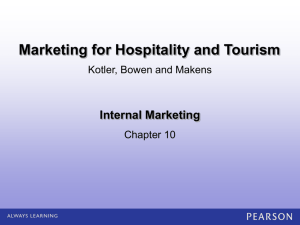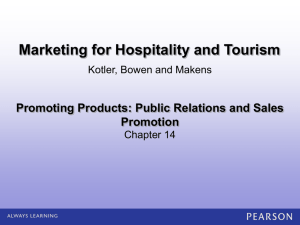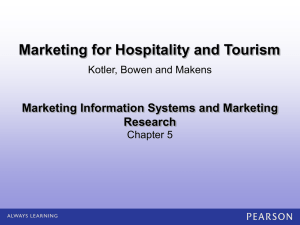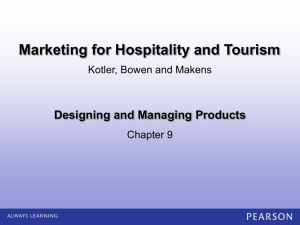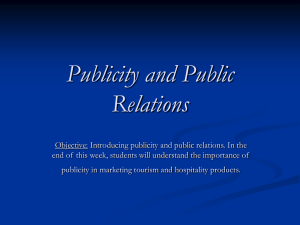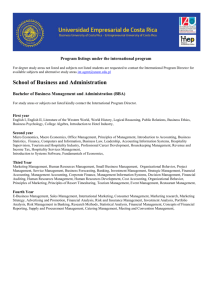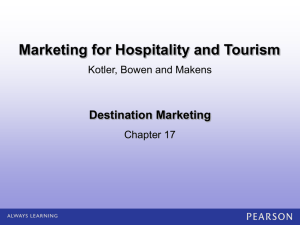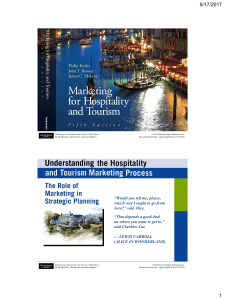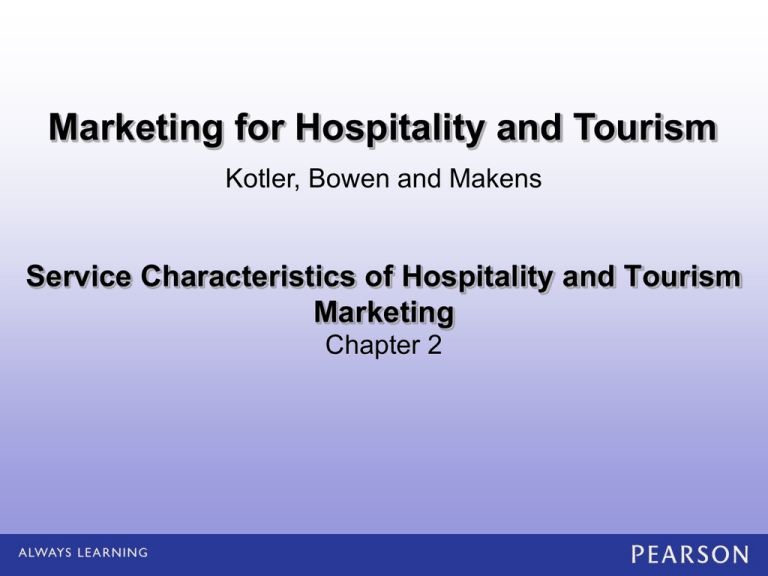
Marketing for Hospitality and Tourism
Kotler, Bowen and Makens
Service Characteristics of Hospitality and Tourism
Marketing
Chapter 2
Learning Objectives
1. Describe a service culture.
2. Identify four service characteristics that affect the
marketing of a hospitality or travel product.
3. Explain seven marketing strategies for service
businesses
Marketing for Hospitality and Tourism, 6e
Kotler, Bowen and Makens
© 2014 by Pearson Higher Education, Inc
Upper Saddle River, New Jersey 07458 • All Rights Reserved
Characteristics of Service Marketing
Characteristics
of Services
Marketing for Hospitality and Tourism, 6e
Kotler, Bowen and Makens
© 2014 by Pearson Higher Education, Inc
Upper Saddle River, New Jersey 07458 • All Rights Reserved
Steps to Reduce Variability
Invest in good hiring
& training
procedures
Standardize
The serviceperformance
process
Marketing for Hospitality and Tourism, 6e
Kotler, Bowen and Makens
Monitor
Customer
Satisfaction
© 2014 by Pearson Higher Education, Inc
Upper Saddle River, New Jersey 07458 • All Rights Reserved
The Service Profit Chain
Internal
service
quality
Satisfied and
loyal
customers
Marketing for Hospitality and Tourism, 6e
Kotler, Bowen and Makens
Satisfied and
productive
service
employees
Greater
service value
Healthy
service
profits and
growth
© 2014 by Pearson Higher Education, Inc
Upper Saddle River, New Jersey 07458 • All Rights Reserved
Types of Marketing
Internal
Marketing
Marketing for Hospitality and Tourism, 6e
Kotler, Bowen and Makens
Service
Marketing
Interactive
Marketing
© 2014 by Pearson Higher Education, Inc
Upper Saddle River, New Jersey 07458 • All Rights Reserved
Marketing Strategies
Service
Differentiation
Service
Quality
Employees
As Part Of
The Product
Marketing for Hospitality and Tourism, 6e
Kotler, Bowen and Makens
Perceived
Risk
Service
Productivity
Customer
Complaints
Capacity
and
Demand
© 2014 by Pearson Higher Education, Inc
Upper Saddle River, New Jersey 07458 • All Rights Reserved
Recommendations for Improving
Service Quality
1. Listening
6. Surprising customers
2. Reliability
7. Fair play
3. Basic service
8. Teamwork
4. Service design
9. Employee research
5. Recovery
10. Servant leadership
Marketing for Hospitality and Tourism, 6e
Kotler, Bowen and Makens
© 2014 by Pearson Higher Education, Inc
Upper Saddle River, New Jersey 07458 • All Rights Reserved
Capacity Management
Involve the Customer in the Service Delivery System
Cross-Train Employees
Use Part-Time Employees
Rent or Share Extra Facilities and Equipment
Schedule Downtime During Periods of Low Demand
Change the Service Delivery System
Marketing for Hospitality and Tourism, 6e
Kotler, Bowen and Makens
© 2014 by Pearson Higher Education, Inc
Upper Saddle River, New Jersey 07458 • All Rights Reserved
Demand Management
Use Price to Create or Reduce Demand
Use Reservations
Overbook
Revenue Management
Use Queuing
Shift Demand
Create Promotional Events
Marketing for Hospitality and Tourism, 6e
Kotler, Bowen and Makens
© 2014 by Pearson Higher Education, Inc
Upper Saddle River, New Jersey 07458 • All Rights Reserved
Tips for Managing Waiting Lines
1. Unoccupied time feels longer than occupied
time
2. Unfair waits are longer than equitable waits
3. Uncertain Waits Are Longer than Known, Finite
Waits
Marketing for Hospitality and Tourism, 6e
Kotler, Bowen and Makens
© 2014 by Pearson Higher Education, Inc
Upper Saddle River, New Jersey 07458 • All Rights Reserved
Key Terms
Interactive marketing Marketing
Physical evidence Tangible clues
by a service firm that recognizes
perceived service quality depends
heavily on the quality of the buyer–
seller interaction.
such as promotional material,
employees of the firm, and the physical
environment of the firm. Physical
evidence is used by a service firm to
make its product more tangible to
customers.
Internal marketing Marketing by a
service firm to train effectively and
motivate its customer-contact
employees and all the supporting
service people to work as a team to
provide customer satisfaction.
Revenue management A pricing
method using price as a means of
matching demand with capacity.
Service culture definition to look
Organization image The way a
like this. Definition to look like this.
person or group views an organization.
Marketing for Hospitality and Tourism, 6e
Kotler, Bowen and Makens
© 2014 by Pearson Higher Education, Inc
Upper Saddle River, New Jersey 07458 • All Rights Reserved
Key Terms (cont.)
Service inseparability A major
characteristic of services; they are
produced and consumed at the
same time and cannot be
separated from their providers,
whether the providers are people
or machines.
Service intangibility A major
characteristic of services; they cannot
be seen, tasted, felt, heard, or smelled
before they are bought.
Service-profit chain A model that
shows the relationships between
employee satisfaction, customer
satisfaction, customer retention, value
creation, and profitability.
Service variability A major
characteristic of services; their quality
may vary greatly, depending on who
provides them and when, where, and
how they are provided.
Service perishability A major
characteristic of services; they cannot
be stored for later use.
Marketing for Hospitality and Tourism, 6e
Kotler, Bowen and Makens
© 2014 by Pearson Higher Education, Inc
Upper Saddle River, New Jersey 07458 • All Rights Reserved


